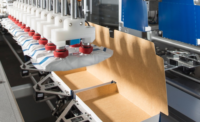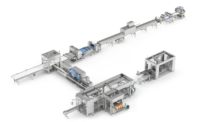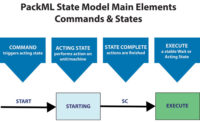Flexible bags remain one of the most popular packaging formats in the snack industry due to their excellent barrier properties, cost-effective production and consumer convenience. High-speed vertical form, fill and seal (VFFS) technology offers significant advantages in this category because it enables manufacturers to maintain ambitious throughput targets and optimum productivity. However, it’s not just about speed when it comes to selecting the right VFFS equipment. A low reject rate; high level of flexibility; ease of maintenance, operation and integration; and a low environmental footprint are all things to consider before specifying a new machine. Here are five key attributes manufacturers should look for to find a packaging system that can operate at maximum speeds while also delivering the highest level of overall equipment efficiency (OEE).
1) Optimize Efficiency with Automation
Equipment automation can be witnessed across the entire food industry. It optimizes throughput rates, eliminates human error and reduces costs. As a result, many packaging equipment manufacturers now supply a range of intelligent controls systems that offer snack manufacturers a single point of control, increased production transparency, enhanced line efficiency and OEE. The latest technological advancements in this area have resulted in the development of intuitively designed systems powered by self-learning software, enabling VFFS machines to strike a balance between advanced packaging speeds, low waste and high product quality.
With an effective controls system in place, manufacturers are able to collect and evaluate detailed and reliable data from the entire packaging process. Barcode scanning and in-line monitoring systems, for example, ensure products are always within specification and adhere to all food safety regulations, with accurate labeling to correctly identify what is within the packaging. In addition, food packagers can record information about their processes, enabling them to rectify any issues and have the documentation available to meet record-keeping requirements. Not only does this speed up production, it also creates a greater level of transparency and accountability within the manufacturing process.
2) Integrate Easily with Turnkey Solutions
Controls systems have proven highly effective when it comes to process optimization, and as a result, many equipment manufacturers are now offering controls technology as part of their complete packaging solution. But it’s not just controls systems that form part of the mix. Also, an increasing number of OEMs will offer a wide range of integrated innovations that support flexibility and speed during the packaging process. From precision scales to high-speed metal detectors to automated film splicers, the move from specifying a single product to a complete packaging system can be witnessed across the entire food industry.
These turnkey systems help toward improving system integration. Many manufacturers undervalue the importance of taking a step back and looking at the complete line. While it’s easy to spend an entire budget on the latest state-of-the-art technology, it’s not guaranteed to bring the best results once combined with existing equipment. After all, the speed at which the bagger can operate is also influenced by the speed of other components that make up the line. For instance, a bagger may be able to pack bags of potato chips at a rate of 150 bags per minute, but if the scale can only handle 80 weighs per minute, the overall productivity will be reduced. Manufacturers must ensure that all elements of the production line can achieve similar levels of outputs to boost their overall efficiency.
3) Reduce Waste with Innovative Design
To reduce waste it’s important to think beyond product waste. Waste also relates to the materials used to package the product, as well as the energy used to run the machine. For example, packaging film is a major financial outlay when bagging snacks, so any steps toward reducing film wastage is a vital consideration.
Accurate and controlled film feed and tracking systems now form a fundamental part of many leading VFFS packaging systems. The latest film splicing technology makes it possible for a new roll of film to automatically start once a previous roll has run out, reducing downtime and keeping the packaging process moving at high speeds. Sensors that detect when the film has moved outside its predetermined range and activate a motor to realign it can be fitted to help reduce product and film waste.
Many packaging manufacturers have started increasing their environmental credentials and supply environmentally friendly systems that reduce waste and contribute to a more sustainable production process. With energy prices soaring, keeping a close eye on consumption levels is essential to maintain profitability. Manufacturers should ensure that their packaging machine is designed to use minimal air and power consumption, and that it comes with standby options within the software to turn off the power to non-essential functions when not in use.
4) Quick Maintenance & Simplicity
Minimizing periods of downtime for setup, repairs and cleaning is another key consideration. Every minute that a manufacturing line is stopped results in lost opportunity and potential revenue. To reduce the disruption caused by such factors, manufacturers should look for equipment that includes free-standing components that can be easily removed or swapped to avoid significant disruptions to continued output. Simply designed machines with a small number of moving parts are also easier to clean — there is less equipment to dismantle, making the process much quicker, and fewer places for microorganisms to hide and harmful bacteria to build up.
In addition, packaging systems with fewer moving parts also reduce the need for setting up additional equipment. VFFS packaging systems that use simple gravity to transfer the product from the weigher through the metal detector and into the forming tube ensure that any product interference by the equipment is kept to a minimum. This results in reduced product damage during the packaging process — i.e., fewer broken potato chips and ultimately less waste. A simple design also ensures the equipment removes non-value items as part of the drive toward LEAN manufacturing, which dramatically reduces spare part requirements and overall cost of ownership.
5) Equipment Flexibility Meets Future Needs
When it comes to choosing the right VFFS equipment, manufacturers should make sure they’re not just looking at their current needs but also take into consideration their future requirements. Consumer tastes and preferences change quickly. In order to keep up, manufacturers need equipment that can offer the highest level of flexibility to handle new materials, package sizes and varying line speeds. VFFS equipment should be able to handle a variety of bag formats on the same line and provide ease-of-use when switching from one to another. The more flexible the packaging machine, the less time is required to change production runs to accommodate different size packages, resulting in minimum interruption to the production flow.
The latest VFFS machines have been designed to support these requirements for flexibility. No mechanical adjustments are needed when changing product or film, for example, plus digital data settings have been incorporated into the systems for rapid product or pack changes. Many machines now allow for quick former changes and any combination of jaw size or configuration (rotary single, double, triple or rotary flat jaw), granting full flexibility of bag size and format, film type and application on a single system. That way, snack manufacturers can be sure they are able to respond to consumer trends quickly and efficiently without having to make costly and time-consuming changes to their production setup.
Speeding up their packaging lines is a fundamental goal for many manufacturers to keep up with growing consumer demand. While increased throughput is a key consideration when selecting a VFFS machine, it’s important to not lose sight of the overall performance of the chosen equipment. Choosing a machine that offers the speed, but also the simplicity and flexibility while incorporating innovative technology, can help manufacturers achieve their output goals while also ensuring a high level of OEE is maintained.
tna is a leading global supplier of integrated food processing and packaging solutions with more than 14,000 systems installed across more than 120 countries. The company provides a comprehensive range of products including materials handling, processing, cooling, freezing, coating, distribution, seasoning, weighing, packaging, inserting and labeling, metal detection and verification solutions. Visit tnasolutions.com.



